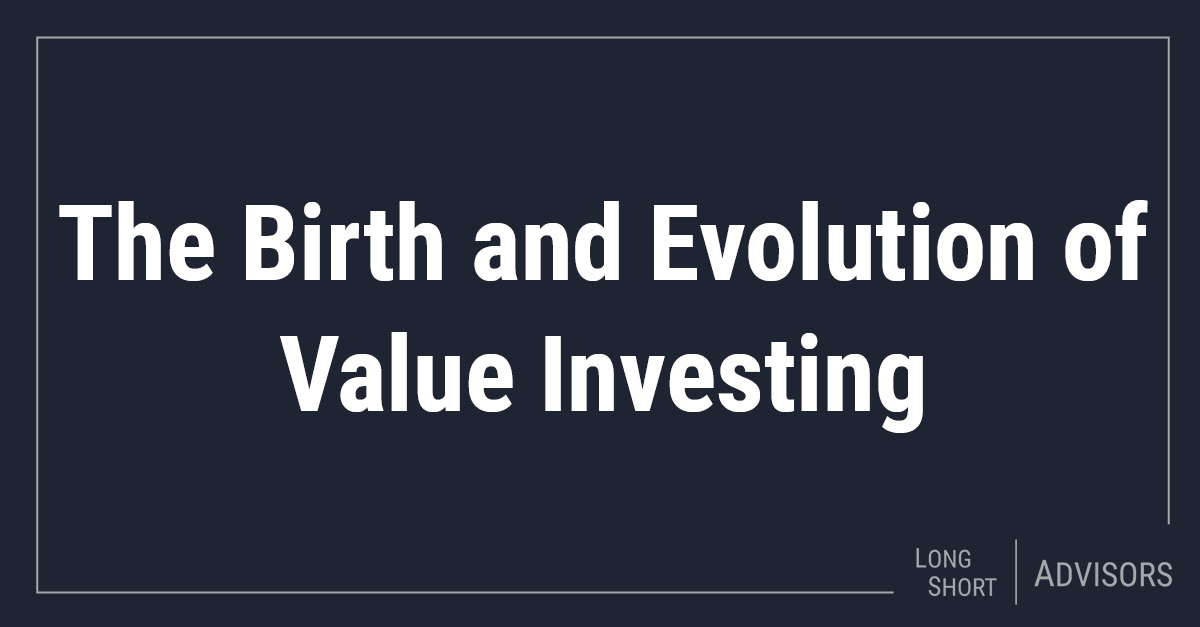The Birth and Evolution of Value Investing
The investment world often seems to be hung up on a putative dichotomy between value and growth stocks. Mutual funds are labeled “growth” or “value” and confined to style boxes; fund managers and market strategists debate whether it’s time for growth or value to prevail in the marketplace. But just what is “value investing” and what is its history? The second question is easier to answer; the first question is more open to interpretation today.
The principles and discipline of value investing were developed a century ago, in the 1920s, at Columbia Business School by Benjamin Graham and David Dodd, who co-authored Security Analysis in 1934. In this classic text, they introduced some of the key concepts of value investing such as seeking to invest at a large discount to a company’s “intrinsic value,” which considers the firm’s assets, earnings, and dividends (the lower the price relative to the security’s IV, the larger the “margin of safety”). The investor’s job was to identify securities that traded at steep discounts to IV—say, 30% to 50% below liquidation value—and, instead of attempting to predict price movements, hold the asset until the market awoke and the price of the common stock rose to converge with its intrinsic value.
At Columbia, Prof. Graham had a student named Warren Buffett, who earned his MS in 1951. Buffett, chairman and CEO of Berkshire Hathaway, is credited with adopting what he learned from Ben Graham and becoming the foremost—and wealthiest--practitioner of “value investing.”
The Rise and Rise of Intangible Assets
Of course, “value investing” has evolved over time. Buffett credits his longtime business partner, Charlie Munger (who passed away last November at age 99), for broadening his investment horizon. Back in Graham’s day, when tangible assets such as equipment and land dominated book value, Buffett would seek to identify businesses (which could be rather mediocre businesses) that traded at significant discounts to book value, or shareholders’ equity. Munger taught Buffett to pivot and look for high-quality businesses with outstanding management and durable competitive advantages that traded at significant discounts to projected future cash flows. As Buffett himself put it, “It is far better to buy a wonderful company at a fair price than a fair company at a wonderful price.”
A good illustration of this strategy was when Buffett began investing in Coca-Cola stock in a big way in 1988. Coke’s brand name is arguably its most valuable asset, yet this intangible asset doesn’t even appear on the company’s balance sheet. In fact, during the past few decades, as the US moved from an industrial- to a knowledge- and service-based economy, the rise of intangible assets such as R&D, intellectual property, software, and customer relations has made security analysis far more complex and has often blurred the distinction between growth and value. For example, R&D is expensed on the income statement, so it depresses short-term earnings, yet it’s also not capitalized on the balance sheet even though it may be crucial to the future profitability and success of a company. Perhaps standard GAAP accounting just hasn’t kept pace with the economy and security valuation.
As a result, figures for book value can be almost meaningless. For example, Eli Lilly’s development of blockbuster anti-obesity medications has propelled the security’s price-to-book value to a stratospheric 50; chip giant Nvidia’s shares trade at 49 times book value.
Over the years, Buffett has come to eschew labels like growth and value. To him, growth is a component of value—a value stock could simply be a mispriced growth company, and a growth company could appear more like a value stock when qualitative adjustments to financial statements are made for intangibles such as outstanding management, brand value, and customer service. “Growth and value investing are joined at the hip,” Buffett says. “Growth is part of the value equation.” One of Munger’s favorite stocks, for example, was Costco, which always appears expensive by certain traditional metrics yet never fails to compound nicely over time. Let’s not forget that years ago a single ratio such as price/book value of a company was often used to determine if a security belonged in the value or growth camp.
Today, there are many forms of “value investing.” For example, one of the characteristics of Prospector Partners, the subadvisor for the LS Opportunity Fund, is that it approaches value investing from a credit perspective, viewing equities through a credit lens. It first scrutinizes a company’s balance sheet (financial statements that are relatively difficult to manipulate), and then moves on to the cash flow statement prior to the income statement. Careful study of the balance sheet reveals not only a company’s leverage, but also potential problems, which helps to provide risk management for long stock positions and to identify lurking weaknesses in companies suitable for short positions.
Disclosures:
As of 01/31/2024, the Fund contained 62 long positions in the portfolio representing companies with what management believes represents long-term value and favorable characteristics such as a discount to market value, attractive free cash flow yields, and strong balance sheets. The Fund’s top 10 long positions represented approximately 28% of the portfolio and included Progressive Corp (PGR) 3.4%, Globe Life Inc (GL) 2.9%, Fairfax Financial Holdings (FRFHF) 2.9%, Eaton Corp (ETN) 2.8%, Leidos Holdings Inc (LDOS) 2.7%, Brown & Brown (BRO) 2.7%, Abbott Labs (ABT) 2.6%, Pioneer Natural (PXD) 2.5%, Merck & Company (MRK) 2.5%, and Citigroup Inc (C) 2.1%. Current and future portfolio holdings are subject to risk and change.
17914615-UFD 02/21/2024







